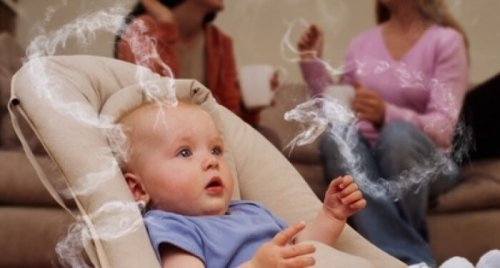How Does Second-hand Smoke Affect Children?

A few decades ago smoking was allowed just about everywhere. Cigarettes were even seen as socially acceptable. Yet the effects of second-hand smoke were still unknown.
Tolerance towards cigarettes was justified by the lack of information on its harmful health effects. Over the years, advances in scientific research have shown that tobacco use produces irreversible damage to the body.
Among the most common and least severe diseases include halitosis, also known as bad breath, increase in chances of tooth decay and deterioration of facial skin.
More serious problems include erectile dysfunction, problems of reproduction, different types of cancer, circulatory system diseases and digestive system diseases.
Smoke-free laws had unexpected negative effects on children
The consequences of cigarette smoke led to the creation of smoke-free laws in major cities around the world. They began educational campaigns with posters, billboards and even on cigarette cases to prevent use and lower addiction.

This measure has created surprising negative effects that weren’t expected. While not being able to smoke in offices, cafes, restaurants or other public spaces, parents tend to smoke more while driving or when they come home, most often in the presence of their children.
Children, the main passive smokers
Anti-tobacco regulations have reduced the involuntary consumption of nicotine of adult passive smokers.
A study by the University of Granada states that this reduction has reached up to 90%. However, this same study indicates that children have become the main passive smokers.
Researchers at the Institute of Biosanitary Investigation did a study with urine samples collected before the beginning of the smoke-free law that was passed in 2011.
The result showed that more than 50% of the children from the study, were passive smokers. In addition, the levels of nicotine found in their urine after the creation of the law had increased.
The study also concluded that several factors influence children’s exposure to tobacco smoke, such as parents’ education or socio-economic levels.
The health of passive smoking children
When a parent or another family member smoke, children are exposed to second-hand smoke. That is, children are susceptible to inhaling the smoke that is produced from the exhalation of smokers or the one produced when the cigarette burns.
In addition, the harmful effects that arise from smoking, impact the fetus from the moment of pregnancy.

Smoke contains multiple toxic substances harmful to health that don’t disappear even when the cigarette is done. These substances remain for some time on various surfaces at home such as toys, furniture and walls.
What are the consequences of tobacco smoke on children?
- Sudden death. Cigarette smoke increases the risk of sudden infant death syndrome. This is one of the leading causes of death in children under 1 year old. The most frequent hypothesis in medical research is that it prevents the central nervous system from maturing. Therefore, there is abnormal cardiological and respiratory activity.
- Respiratory diseases. Passive smoking children may develop chronic cough, bronchitis and pneumonia. The chances of being in a smoking environment increase between 50 and 100%. Another common risk is the appearance of asthma and different types of allergies.
- Otitis. Exposure to tobacco smoke can cause ear infections, because it’s connected to the respiratory system.
- Cancer. Exposure to these 40 carcinogenic substances released from smoking increases the chances of developing different types of cancer in adulthood. These probabilities increase as the years of exposure to tobacco increase. It also affects the number of smokers you have at home.
- Cardiovascular diseases. Symptoms of circulatory system diseases occur in adulthood. However, the anatomical changes that they create, originate during childhood. Tobacco smoke influences the appearance of these same changes.
The best recommendation for parents is to do their best to quit tobacco addiction to preserve their children’s health.
If it isn’t possible, it’s suggested to prevent your children from having any contact with toxic substances associated with tobacco at all costs.
A few decades ago smoking was allowed just about everywhere. Cigarettes were even seen as socially acceptable. Yet the effects of second-hand smoke were still unknown.
Tolerance towards cigarettes was justified by the lack of information on its harmful health effects. Over the years, advances in scientific research have shown that tobacco use produces irreversible damage to the body.
Among the most common and least severe diseases include halitosis, also known as bad breath, increase in chances of tooth decay and deterioration of facial skin.
More serious problems include erectile dysfunction, problems of reproduction, different types of cancer, circulatory system diseases and digestive system diseases.
Smoke-free laws had unexpected negative effects on children
The consequences of cigarette smoke led to the creation of smoke-free laws in major cities around the world. They began educational campaigns with posters, billboards and even on cigarette cases to prevent use and lower addiction.

This measure has created surprising negative effects that weren’t expected. While not being able to smoke in offices, cafes, restaurants or other public spaces, parents tend to smoke more while driving or when they come home, most often in the presence of their children.
Children, the main passive smokers
Anti-tobacco regulations have reduced the involuntary consumption of nicotine of adult passive smokers.
A study by the University of Granada states that this reduction has reached up to 90%. However, this same study indicates that children have become the main passive smokers.
Researchers at the Institute of Biosanitary Investigation did a study with urine samples collected before the beginning of the smoke-free law that was passed in 2011.
The result showed that more than 50% of the children from the study, were passive smokers. In addition, the levels of nicotine found in their urine after the creation of the law had increased.
The study also concluded that several factors influence children’s exposure to tobacco smoke, such as parents’ education or socio-economic levels.
The health of passive smoking children
When a parent or another family member smoke, children are exposed to second-hand smoke. That is, children are susceptible to inhaling the smoke that is produced from the exhalation of smokers or the one produced when the cigarette burns.
In addition, the harmful effects that arise from smoking, impact the fetus from the moment of pregnancy.

Smoke contains multiple toxic substances harmful to health that don’t disappear even when the cigarette is done. These substances remain for some time on various surfaces at home such as toys, furniture and walls.
What are the consequences of tobacco smoke on children?
- Sudden death. Cigarette smoke increases the risk of sudden infant death syndrome. This is one of the leading causes of death in children under 1 year old. The most frequent hypothesis in medical research is that it prevents the central nervous system from maturing. Therefore, there is abnormal cardiological and respiratory activity.
- Respiratory diseases. Passive smoking children may develop chronic cough, bronchitis and pneumonia. The chances of being in a smoking environment increase between 50 and 100%. Another common risk is the appearance of asthma and different types of allergies.
- Otitis. Exposure to tobacco smoke can cause ear infections, because it’s connected to the respiratory system.
- Cancer. Exposure to these 40 carcinogenic substances released from smoking increases the chances of developing different types of cancer in adulthood. These probabilities increase as the years of exposure to tobacco increase. It also affects the number of smokers you have at home.
- Cardiovascular diseases. Symptoms of circulatory system diseases occur in adulthood. However, the anatomical changes that they create, originate during childhood. Tobacco smoke influences the appearance of these same changes.
The best recommendation for parents is to do their best to quit tobacco addiction to preserve their children’s health.
If it isn’t possible, it’s suggested to prevent your children from having any contact with toxic substances associated with tobacco at all costs.
This text is provided for informational purposes only and does not replace consultation with a professional. If in doubt, consult your specialist.








